#century india
Explore tagged Tumblr posts
Text
Götheborg of Sweden in London
#tall ship#east india company#swedish#götheborg of sweden#18th century#age of sail#replica#merchant vessel#london bridge#beware there is music in the video
2K notes
·
View notes
Text

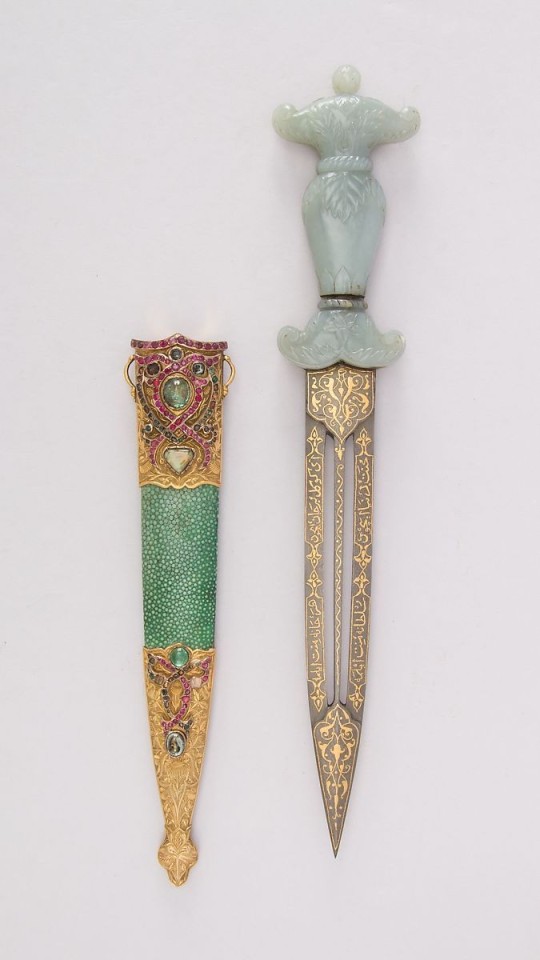
18th century daggers from India and Turkey
14K notes
·
View notes
Text
Emerald Spectacles from India, c. 1620-1660 CE: the lenses of these spectacles were cut from a single 300-carat emerald, and it was believed that they possessed mystical properties
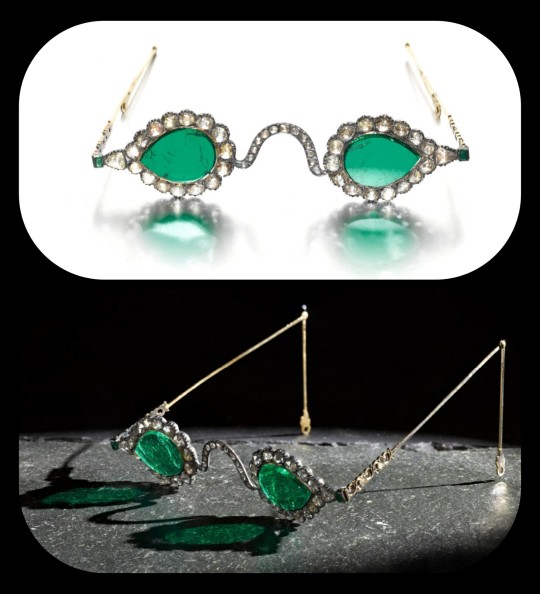
These eyeglasses are also known by the name "Astaneh-e ferdaws," meaning "Gate of Paradise," based on the symbolic associations between the color green and the concept of spiritual salvation/Paradise. That symbolism (which is rooted in Islamic tradition) was especially popular in Mughal-era India, where the spectacles were made.
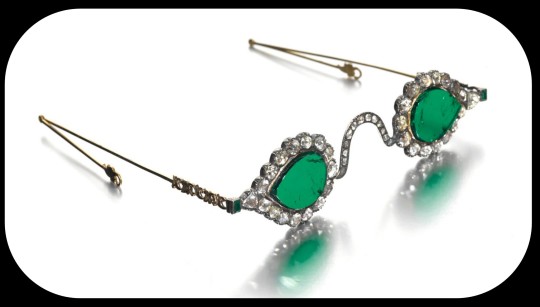
The lenses were crafted from two thin slices of the same emerald. Together, the lenses have a combined weight of about 27 carats, but given the precision, size, and shape of each lens, experts believe that the original emerald likely weighed in excess of 300 carats (more than sixty grams) before it was cleaved down in order to produce the lenses. The emerald was sourced from a mine in Muzo, Colombia, and it was then transported across the Atlantic by Spanish or Portuguese merchants.
Each lens is encircled by a series of rose-cut diamonds, which run along an ornate frame made of gold and silver. The diamond-studded frame was added in the 1890s, when the original prince-nez design was fitted with more modern frames.
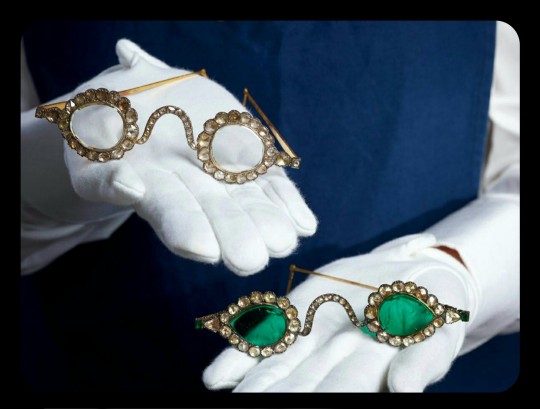
The emerald eyeglasses have long been paired with a second set of spectacles, and they were almost certainly commissioned by the same patron. This second pair is known as "Halqeh-e nur," or the "Halo of Light."
The Halo of Light features lenses that were made from slices of diamond. The diamond lenses were cleaved from a single stone, just like the emerald lenses, with the diamond itself being sourced from a mine in Southern India. It's estimated that the original, uncut diamond would have weighed about 200-300 carats, which would make it one of the largest uncut diamonds ever found.
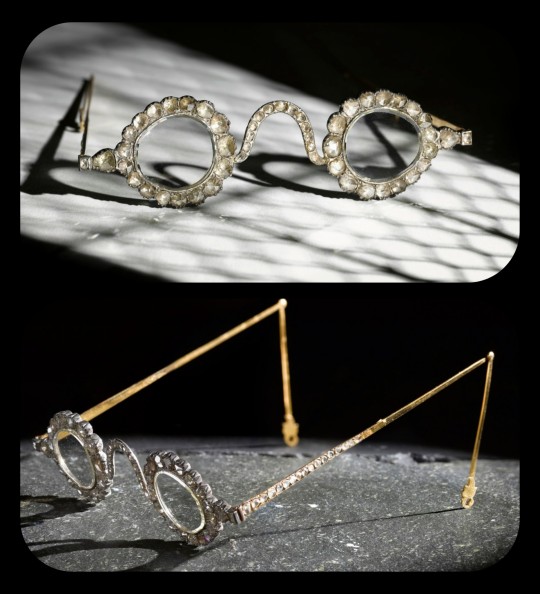
The lenses are so clear and so smoothly cut that it sometimes looks like they're not even there.
Both sets of spectacles date back to the mid-1600s, and it's generally believed that they were commissioned by a Mughal emperor or prince. The identity of that person is still a bit of a mystery, but it has been widely speculated that the patron was Shah Jahan -- the Mughal ruler who famously commissioned the Taj Mahal after the death of his wife, Mumtaz Mahal. Shah Jahan did rule as the Mughal emperor from about 1628 to 1658.
The emerald and diamond lenses may have been chosen for symbolic, sentimental, and/or cultural reasons, or they may have been chosen simply because they're pretty and extravagant; the original meaning and purpose behind the design is still unclear. Experts do believe that the eyeglasses were designed to be worn by someone, though.
At times, it was believed that the spectacles had spiritual properties, like the ability to promote healing, to ward off evil, to impart wisdom, and to bring the wearer closer to enlightenment. Those beliefs are largely based on the spiritual significance that emeralds and diamonds can have within certain Indic and Islamic traditions -- emeralds may be viewed as an emblem of Paradise, salvation, healing, cleansing, and eternal life, while diamonds are similarly associated with enlightenment, wisdom, celestial light, and mysticism.

The Gate of Paradise and the Halo of Light were both kept in the collections of a wealthy Indian family until 1980, when they were sold to private collectors, and they were then put up for auction once again in 2021. They were most recently valued at about $2 million to $3.4 million per pair.
Sources & More Info:
Sotheby's: Mughal Spectacles
Architectural Digest of India: At Sotheby's auction, Mughal-era eyeglasses made of diamond and emerald create a stir
Only Natural Diamonds: Auspicious Sight & the Halqeh-e Nur Spectacles
The Royal Society Publishing: Cleaving the Halqeh-Ye Nur Diamonds
Gemological Institution of America: Two Antique Mughal Spectacles with Gemstone Lenses
Manuscript: From Satan's Crown to the Holy Grail: emeralds in myth, magic, and history
CNN: The $3.5 million Spectacles Said to Ward off Evil
BBC: Rare Mughal Era Spectacles to be Auctioned by Sotheby's
#history#archaeology#artifact#mughal#india#17th century#art#emerald#diamond#glasses#indian lore#islam#religion#mysticism#indian history#anthropology#spirituality#fashion
5K notes
·
View notes
Text


▪︎ Ewer and Tray.
Date: 4th quarter of the 16th century; 1st quarter of the 17th century (around 1585 - 1615)
Place of origin: Gujarat, India
Medium: Mother-of-pearl, shell.
#17th century#art#history#16th century#decorative arts#history of art#16th century art#17th century art#india#asian arts#gujarat#ewer#tray#shell#mother of pearl#1585#1615
254 notes
·
View notes
Text

Brass astrolabe, India, mid 17th century
from The British Museum
703 notes
·
View notes
Text

In the 5th century BCE, Sushruta, a renowned Indian surgeon, first identified diabetes by observing that diabetics’ urine attracted ants due to its sweetness. He noted that the condition primarily affected wealthier individuals and linked it to a diet high in rice and sweets.
165 notes
·
View notes
Photo
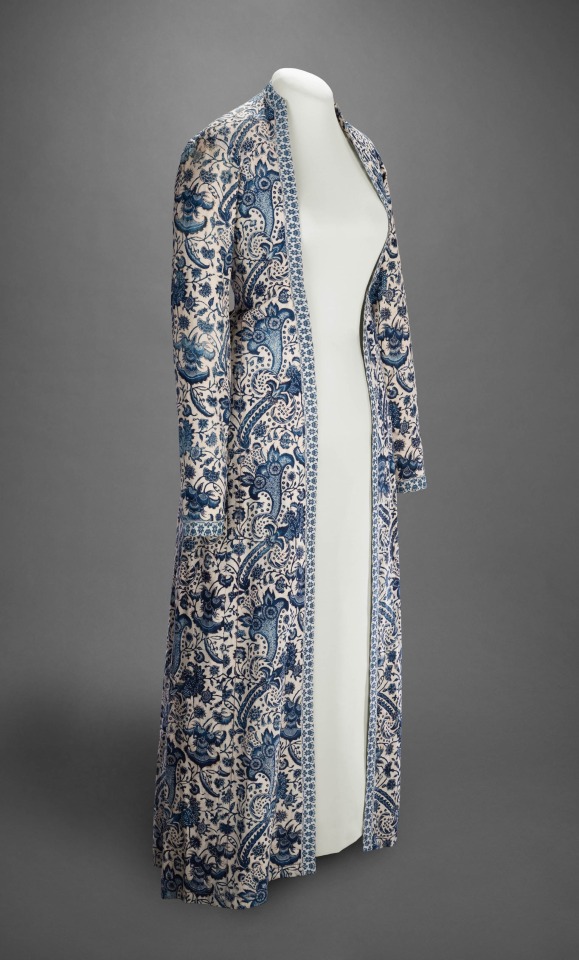
Wentke (Gown)
Mid 18th Century
The Netherlands
Women in Hindeloopen, a town in the northern Netherlandish province of Friesland, traditionally wore this type of striking lightweight coat, called a wentke, on special occasions. Beginning in the mid-eighteenth century, wentkes were usually made of boldly patterned Indian chintzes, and contrary to the custom in the rest of Europe of confining chintz to casual and private occasions, residents of Hindeloopen elevated this exotic fabric to a formal status. The wentke was often worn with other garments of Indian cotton. (The MET)
Peabody Essex Museum (Object Number: 2012.22.15)
#wentke#gown#jacket#georgian#1730s#1740s#1750s#1760s#regional fashion#18th century#dutch#the netherlands#blue#cotton#india#chintz#peabody essex museum#popular
3K notes
·
View notes
Text

Ceremonial cloth with mata hari (‘eye of the day’) design, 18th or 19th century, Coromandel Coast, India, dyes and mordants on cotton.
270 x 240 cm
Apollo Magazine / Collection of Karun Thakar
606 notes
·
View notes
Text
Ms. Coll. 390, Item 2676, is a picture book, containing drawings and miniature paintings of birds and animals, mythological beings, scenes of daily life, court scenes, and more. Many of the pictures are unfinished, upside-down or overpainted, suggesting a work in progress or a sketchbook. It is written in Sanskrit, circa 1700-1850.
🔗:
#manuscript#sanskrit#south asia#18th century#19th century#drawings#art#history of art#indian art#india#animals#birds#painting#sketchbook#picture book#book history#rare books
335 notes
·
View notes
Text

Götheborg of Sweden in London, 2022
563 notes
·
View notes
Text

Ceremonial Sword, steel blade, gold hilt, inlaid with diamonds, rubies, and emeralds. Hyderabad, South India, 1880–1900.
#dark academia#light academia#academia aesthetic#classical#academia#escapism#classic literature#books#books and libraries#architecture#object#sword#gold#jewels#south india#1800s#19th century#royal core#cottage core#aesthetic
2K notes
·
View notes
Text




ENGRAVED AXE
Robust cusp of square section with remains of engravings; long, convex-edged axe finely engraved with floral motifs on a dark background and with gold frames. Rear fluke decorated with a fawn amidst floral motifs, center of crossguard decorated in gold. Engraved cylindrical shaft with button at the end
India, Late 19th Century
length 73.5 cm.
© CZERNY’S INTERNATIONAL AUCTION HOUSE S.r.l.
114 notes
·
View notes
Text
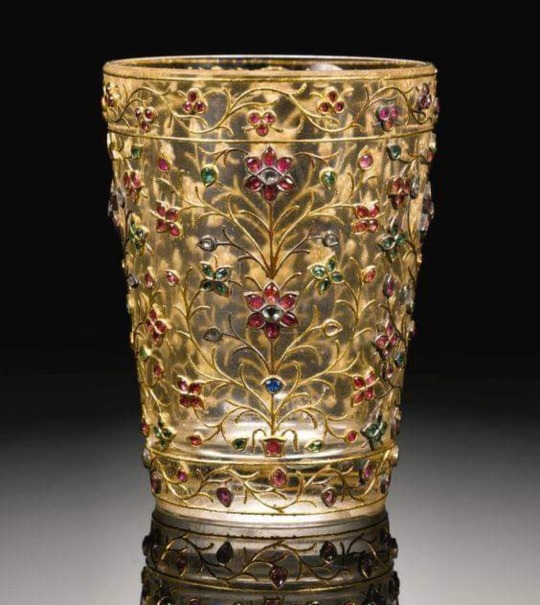
Mughal Gem-Set Rock Crystal Cup, India, Circa 18th Century
Source: Luxury Porcelain @ Facebook
#mughal#india#indian high jewelry#rock crystal#precious gems#work of art#18th century#high jewelry#luxury jewelry#fine jewelry#fine jewellery pieces#gemville
617 notes
·
View notes
Text
Did you know that the first map of the Himalayas was made in the 1500s by the Catalan monk Antoni de Montserrat, and it was so accurate that it was used by European expeditions until the 1800s?
Here's the story of a priest that was called by a Mughal emperor for interfaith intercultural dialogue and who ended up being -among other things- a royal teacher, a writer, a geographer, a fake Armenian merchant, and a prisoner.

Antoni de Montserrat was born in 1536 in Vic (Catalonia). He studied in Barcelona (Catalonia) and Coimbra (Portugal) to become a priest and joined the Jesuits. In 1574, he was sent on a mission to Goa (back then a Portuguese colony, now part of India).
The Mughal emperor Akbar was an open-minded man. He was Muslim but wanted to learn about the other religions, so he called representatives of different religions to his court in Fatehpur Sikri. In 1579, he called the Jesuits to explain Christianity, and the Jesuits sent Antoni de Montserrat. Everyone in the court -Muslims, Christians, Buddhists, Hindus- knew that the point was not to convert others, but to reach a better understanding through debate.

The Mughal emperor Akbar holding an assembly with religious men. The two men dressed in black are Jesuits. Miniature painting by Nar Singh, 1605. Chester Beautty Library.
The emperor Akbar valued Antoni de Montserrat as a great wise man and chose him to become the tutor of his second son Murâd. Antoni learned Persian (the language of the Mughal court) and accepted. He remained close to the emperor and accompanied him in the military campaign when the emperor's step-brother started an uprising in Bengala. Crossing much of Northern India, Kashmir, Pakistan, Afghanistan, and Tibet on elephant gave him the perspective to draw the map.
In the end, Antoni went back to Goa in 1582. There, he wrote a book explaining what he had seen in the Mughal Empire, the cultural differences he had experienced, the political organization of these territories, and describing emperor Akbar's court. This book is called Mongolicae Legationis Commentarius, and its descriptions of the lands he has travelled include the earliest description of Tibetans known in Europe since Marco Polo and the first ever map of the Himalayas.

Antoni de Montserrat's map of the Himalayas and their surroundings, including large parts of what nowadays is India, Tibet, Pakistan, and Afghanistan. Library of St. Paul's Cathedral, Kolkata (India).
This book explains cultural elements of the different cultures under the Mughal Empire and also the conversations Antoni had with the emperor about certain habits. For example, Antoni writes about how the Brahmans (upper caste Hindu priests) force widows to be burned alive in the same funeral pyre as their dead husbands, often (when the women resist) drugging them or through violence. Antoni tries to get emperor Akbar to stop this terrible tradition, but doesn't succeed. On the other hand, Antoni also tells the emperor Akbar that they should burn the "men who dress as women" who live in the emperor's court, to which the emperor bursts laughing out loud and doesn't give any consideration to. Despite their different cultural backgrounds, Antoni and Akbar were friends.
Antoni's time in the Mughal Empire ended in 1588, when the king Philip II of Castilla and I of Portugal orders Antoni and a young Spanish priest named Pedro Páez to go to Ethiopia to convince the Coptic Christian Ethiopians to get closer to the Catholic Christian Church. Then, Antoni and Pedro dressed up as an Armenian merchants to border the Ottoman Empire through Iraq, Syria, and Egypt, trying to avoid the pirates of the Indian Ocean. However, before reaching Ethiopia, they took a ship to skirt modern-day Oman, but the captain turned them in as soon as they reached land in Yemen. Then, Antoni and Pedro were taken on a camel caravan to the Sultan of Hadhramaut (Yemen), who imprisoned them until 1595 and then sentenced to galleys in the Red Sea, and later imprisoned them again. Luckily for them, king Philip paid their rescue and they were freed in 1596. With his body weakened by the galleys and the mistreatments of prison, Antoni retired to a convent in Salsette (modern-day Mumbai, India), where he died in 1600 right after having finished his map.
The Spanish priest who travelled with him, Pedro Páez, also wrote his own diary explaining what they lived. With his descriptions, we know that in Yemen Antoni and Pedro were given what he describes as a kind of herbal tea called "cahua, water boiled with a fruit named bun and which is drank very hot, instead of wine": that is a drink that was still unknown in Europe at the time, which we now call coffee.
Maybe you have heard the name Pedro Páez before, too. After accompanying Antoni to Goa, he went to Ethiopia again, successfully this time. In Ethiopia, he became the first European to reach the source of the Blue Nile.
Information sources: David Montserrat Nonó (La Mira), Sociedad Geográfica Española. If you want to read Antoni de Montserrat's book, it has been translated from Latin to Catalan and to Spanish by Josep Lluís Alay.
#història#antoni de montserrat#pedro páez#mughal empire#mughal#history#catalonia#catalan#renaissance#european history#asian history#asia#india#indian history#interfaith#geography#1500s#16th century#travel#other countries
60 notes
·
View notes
Text
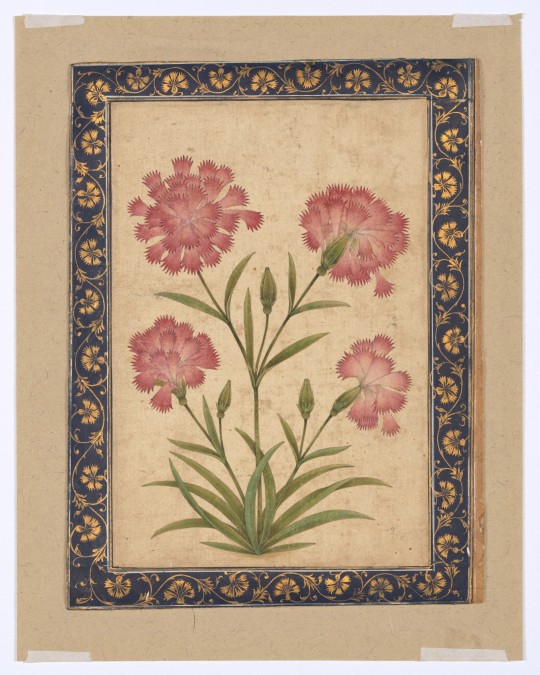
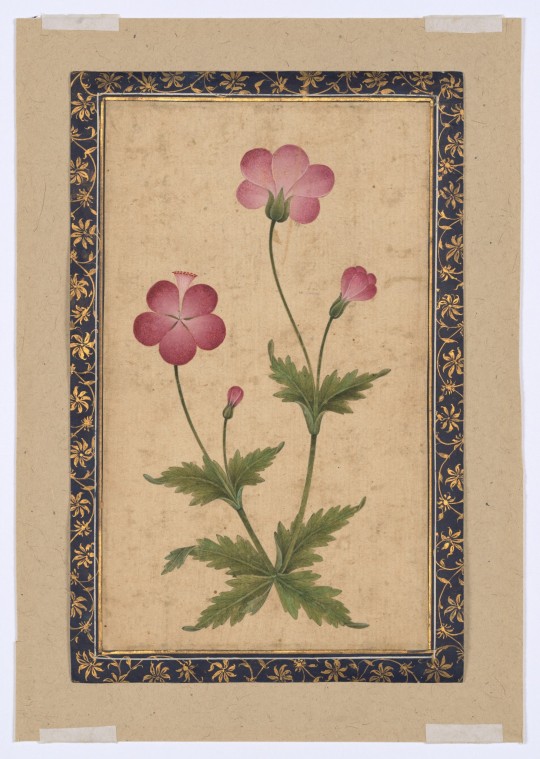

▪︎ Botanical Painting: Dianthus, Composite Flower and Geranium.
Date: ca. 1630
Place of origin: India
Medium: Opaque color on paper
#17th century#art#history#decorative arts#history of art#17th century art#botanical#botanical painting#plants#indian#india#asian arts#ca. 1630#dianthus#composite flower#geranium#flowers
193 notes
·
View notes
Photo
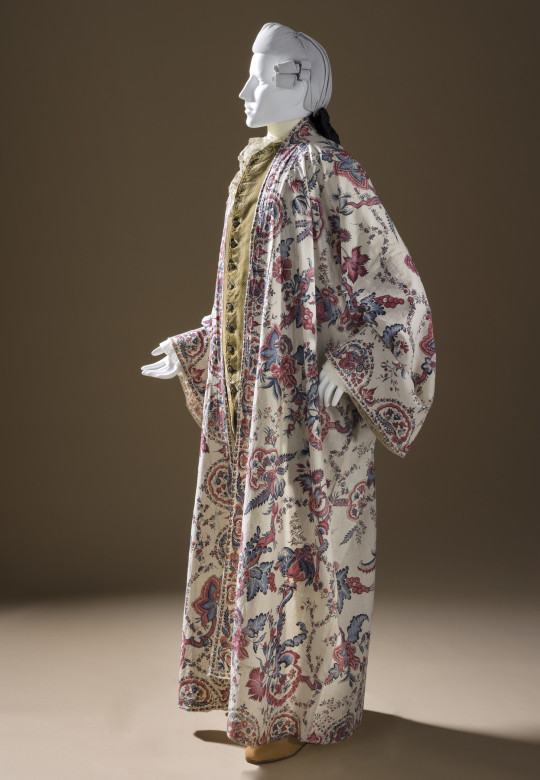

Banyan
c.1750
Coromandel Coast, India for Western Market
LACMA (Accession Number: M.2005.42)
#banyan#fashion history#historical fashion#menswear#mensfashion#1750s#18th century#india#cotton#paint#dye#1750#1755#1759#georgian fashion#georgian era#lacma#fucking LOVE the back
796 notes
·
View notes